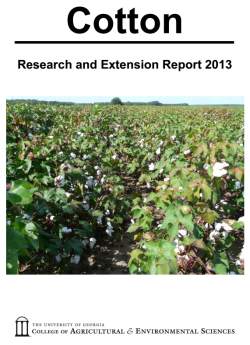
The University of Georgia
College of Agricultural and Environmental Sciences
College of Agricultural and Environmental Sciences
The predominant defining factor describing the 2013 season was abnormally excessive season-long rainfall. Cotton in many areas struggled to get a good start. Substantial water logging occurred in many fields, which significantly delayed or prevented timely application of side-dressing fertilizers and/or layby herbicides.Harvest weather throughout the fall, although cooler than normal, was fairly cooperative. The most common challenges for growers included nematodes, target spot, and glyphosate-resistant pigweed.Despite these and other challenges, many parts of Georgia were blessed with better than expected yields, resulting in a statewide average yield of 831 lbs per acre.
Download the entire report: 2013 Cotton Research-Extension Report (in PDF format) or use the Table of Contents below to click on, view, and download individual papers.
INTRODUCTION
AGRICULTURAL AND APPLIED ECONOMICS
- Economic Analysis of Heavy Rye Cover Crop to Control Glyphosate-Resistant Palmer Amaranth in Cotton
- Economics of Cover Crop and Supplemental Fertilizer in Strip-Tillage Cotton
CROP AND SOIL SCIENCES
- 2013 Cotton OVT Variety Trials
- Evaluation of Performance, Growth, and Fruiting Characteristics of New Cotton Varieties and Quantifying Potential Production Risks of Up-and-Coming Technologies
- The Utility of Plant Water Status Measurements as a Means to Improve Water Use Efficiency in Georgia Cotton Production
- Fertilization and Cover Crop Interactions for Strip-Till Cotton
ENGINEERING
ENTOMOLOGY

